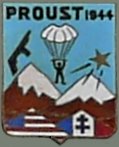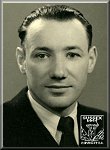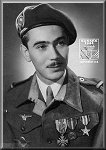|
THE PROUST PLAN

History Proust
Plan
(Published
with the kind permission of Serge Larcher)
The Proust Plan was a creation of circumstance
decided in January 1944 while the Sussex Plan had been launched for
several months and already entered its operational phase. Being a
plan complementary to this last, the first men who will be indicated
come from the surplus of manpower recruited for Sussex.
At the beginning of 1944, the American staff headquarters which
expected enormous difficulties after the Normandy landing (D Day),
wished to reinforce the number of intelligence teams operating in
France. The missions to come were not yet defined but the Normandy
landing being announced like a gigantic challenge, the staff
estimated that specific needs, not covered by the Sussex agents,
would appear at the proper time.
OSS thus wished to use the surplus of Sussex agents, supplemented by
BCRA new recruits from North Africa.
A secret memo (N° 379D/BCRAL), dated February 11, 1944, from BCRA-London
informed the office of Algiers of this new plan and gave the broad
outlines.
Note addressed to the captain Landrieux :
“The American authorities came to me to announce the creation,
beside the tripartite plans Sussex and Jedburgh, of a Proust Plan
intended to train about fifty agents in order to send them by
infiltration or parachuting behind the German lines after the
establishment of a bridgehead in France.
This plan is a joint Franco-American plan known by the British in
which they will not take part. Colonel Neave of the American Army
assumes the direction of it.
Right now a telegram left for Algiers in order to announce the
creation of this new plan and to require the personnel needed to
implement it. American plan to use the agents refused during the
different tests. Herewith a first list of personnel which would have
to be recovered. Please specify me where these personnel are and
stop any assignment within their units of origin of the refused
elements of the various plans until they could be examined by
colonel Neave.
American have put at our disposal a house, instructors and are ready
to receive volunteers from March 1, 1944.
The Proust plan is an intelligence plan to collect relevant
information.
Signed: Major Manuel, chief of the BCRAL”.
Three weeks later, another memo N° 1834/GA/EM/S/A dated March 6,
1944, emanating from the DGSS/BCRAL, and still signed by major
Manuel and sent to the general d’Astier’s attention, military
delegate of the Committee of Action in France, gave some additional
details.
Subject: Proust Plan
“In reference to your note D/A4/R of February 24, 1944 relating to
the Proust plan, I have the honor to inform you that the American
special services wished to have 50 volunteers or more to be put at
their disposal from the D-day.
The Proust Plan which is a derivative of the Sussex Plan has as an
aim the training and the later use, on the sector of the operations
which will be possibly reserved for the American troops, of the
agents whose intellectual background will not have allowed
integration into the Sussex plan.
The Proust Plan of which the principal goal
is the preparation of intelligence agents, does not draw aside the
action completely.
The candidates receive, in very good conditions, a progressive and
complete training in an OSS school located in Horsham (Sussex) …”
In March 1944 the recruitment campaign in North Africa started for
Sussex continued with the profit of Proust. These arrived in England
by small groups or individually.
Thus on March 6, some of future Proust agents embarked in Algiers
accompanied by the last Sussex recruits.
They debarked in Liverpool on March 17, attended the traditional
circuit of new comers to England while passing the security
formalities.
The increase in importance of this new plan did not go without
difficulty. Volunteers “lost themselves” between Algiers and London,
others were seen affected to units upon their arrival without
relationship with Proust.
Some recruits were finally refused, not having the level required by
the persons in charge of the plan.
The set-up of the Proust Plan experienced difficulty. Indeed Sussex
which was already in operational phase absorbed most part of the
means and preserved the priority for training, equipment and
transportation.
Lieutenant-colonel Booth wrote in his book “Proust Mission –
“The story of an unusual OSS undertaking” published by Dorrance &
Comagny – Philadelphia”
about his first contact with Proust while he had just been named
responsible for their instruction.
“There was a problem with some agents already recruited for the
Sussex Plan which were isolated due to agent surplus. Although there
were not officially other reasons particular to be put them away
from this mission, they rather badly lived this situation to which
uncertainty reigning on their possible use in this new plan was
added. Uncertainty felt like a true frustration, causing a great
distress among the selected men who thought of being only one
creation of circumstance, a kind of “wall cupboard” for Sussex
agents not selected. The agents’ moral was somewhat deteriorated
causing some problems of discipline”.
Fault-finders were affirming that there was the uncertainty on the
use of Proust Plan which was at the origin of the code name of this
plan, because it was the cause of much “wasted time” (by analogy
with the book of the famous writer “To the research of wasted
time”), which was false of course, the name having been selected
before the appearance of the problems quoted by Booth but which let
imagine the “stormy” environment which marked the beginnings of
Proust (1).
A resumption in hand proved to be necessary and it was only after
the passage to Ringway to obtain the parachutist badge that the
moral improved quickly.
It was mid-April that the training of about fifty selected agents
was able to start.
The training:
The deployment of the Sussex Plan in France released some American
instructors who from then could devote themselves to Proust. The
agents of the two missions will receive the same training.
The training was conducted at Drungwick Manor (code Area B),
splendid residence of XIIIth century restored during the XIXth by
its owner Gilbert Miller, famous American theatre producer. The
instructors lived in the castle where also were the mess and the
various administrative services while the trainees were installed
under tents in the vast park which was also used as training ground
with various disciplines such as sport, shooting, close combats and
handling of the explosives.
The weekly reports of the commander Dutey French deputy of colonel
Neave gave a status of operations with the British secret services
and various exercises such as preparation of the individual
“covers”, transmission courses, various vehicle driving, study of
the armament, identification etc.
On May 21, Proust manpower counted 65 men. On June 7,
Lieutenant-colonel Booth took the command of the Freehold school,
Neave being recalled to the London OSS.
Thanks to the commander Dutey’s notes, we knew that Proust manpower
having followed the full training never exceeded 65 men in the best
of the cases.
All did not arrive at the end of the training, some having made only
one short passage. To be pointed out that 14 agents were versed in
the Sussex Plan, it was the case in particular of Guy Mocquet and
Lucien Bignon (Daru mission) or of Mario Faivre (Velours mission).
Taking into account of the few French BCRA/OSS liaison officers of
this Plan, we have a precise idea of French manpower being able to
claim to be part of the Proust Plan that was to say less than 80
people.
The mission infiltration was primarily performed by parachuting
except for two teams transported by the OSS maritime section and
landed by PT boat and two other teams infiltrated by plane.
The Proust Missions:
The first mission
"Girafe" was the only mission where one agent was killed in action
(KIA), Joseph Jourden aka Jean-Marie Stur:
He was engaged within the framework of the Sussex Plan under the
name of Jean-Marie Stur. Integrated into the "Proust Plan", mission
Girafe. On June 25, 1944, He was clandestinely debarked by a MTB
with Jean-Marie Robleu (of its true name Robert Reitzer) in the area
of Morlaix, close to the point of Beg year Fry, to transmit to
London the information collected on the ground on the forces, the
positions, the equipment of the German troops likely to be opposed
to the allied forces already landed in Normandy on June 6.
“The girafe got a laryngitis” such was the coded sentence of London
Radio to inform Joseph Michel Jourden that a message was going to be
addressed to him. It succeeded in escaping the German goniometers
until August 9, 1944. The canon Pérenes wrote in "Allied aviators
and tragic days of the liberation in some localities of Finistère"
(1946) the tragic events which resulted in the death of Joseph
Michel Jourden (written starting from the testimony of Mr Ruppe
chaplain in Ploujean): "The American troops had crossed Plouigneau
without any problem on August 8, 1944.
On August 9, an isolated column with two hundred Germans with guns
and others weapons emerged in the borough of Plouigneau. The FFI
fought but they were not numerous enough. Five patriots (Joseph
Michel Jourden and four people (Jean-François Le Coz, Jean-Yves
Ropars, Albert Perrot and X which had arrived by car) holding up the
allied flags and the Lorraine cross were arrested and shot on the
church square". The official French and American versions specified
in connection with Joseph Michel Jourden “Taken by a German
detachment on August 9, he was tortured during four hours on the
village square and in spite of abominable sufferings, he refused to
speak, showing a very high heroism. Being unable to manage to put
him in the upright position, the Germans shot him with a bullet in
his head".
A commemorative plaque can be seen close to the war memorial of
Plouigneau.
The very same day of the drama, Robert Reitzer, team-mate and friend
of Joseph Jourden, informed his family of his death and his body was
transported to his sister’s house in Morlaix. In front of the door
of the burning chapel was standing an armed American soldier. A
detachment of American soldiers and FFI accompanied the hearse to
the cemetery where the military honours were presented to him. He
was made Chevalier of the Legion of Honour (on a purely posthumous
basis), awarded with the Military Cross with bar and the medal of
French Resistance. The US Distinguished Service Cross was given on
June 1, 1945 by an American officer to his father Joseph Jourden on
the square of the town hall of Le Conquet.
The main street of Le Conquet bears his name by decision of the
municipal council of June 6, 1945.
“Midiron” is one of the typical Proust operations.
In connection with the maquis, the agents had to inform the 3rd US
Army about movement of the German Army retreating in direction of
Belfort Gap.
The mission leader was
Jean-Paul
Bougier alias Bricard alias Bartholdi. The mission was parachuted on
July 12, 1944 near Doaudic (Indre). Its objectif was supervising and
announcing the enemy convoys in the sectors of Angouleme, Poitiers,
Le Blanc, Limoges, Château Vieux and Dijon.
This mission was composed of several teams:
|
- “Saniette” Jacques Suissa alias Jacques Grenier
alias Saniette
parachuted on July 12 near
Doaudic
at the same time as
Bernard Duval alias
“Charlus”
- “Congé” Georges Cordeau alias Courtois parachuted the
night of August 7. Make contact with the maquis in the area
of Limoges, information in Angouleme and Poitiers.
- “Poil” Rene Gros alias Bordenave, intelligence mission
leading to the US Air Force bombardment which destroyed an
important concentration of troops enemies. |
Saniette
mission report

file pdf - 773 ko
clic ...
|
The Midiron agents sent 151 messages to the Victor station (Radio
Central of OSS in England) where they were analyzed and dispatched
towards the 7th and 9th US Armies.
“Jambon”
Jean Deschamps alias Alain Aymard parachuted on July 1 in R6,
Haute-Loire.
Settled in Mayenne to establish an intelligence network there.
“Mirnaloy”
Observer Ablard, parachuted on July 10, worked in the area of
Baccarat.
“Commis / Mayfair” Observer Bazin, infiltrated by landing for a
mission in North East of France, search for dropping grounds and
committee of reception.
|
“Jument” Observer Mallet and radio operator Wateau
parachuted on August 16 to 10 km of Montlucon. Material
destroyed with the landing obliging the agents to pass their
information by another channel. The Loire region having been
completely released, the mission returned to Paris on
September 12. |
Bronze Star Medal
from Michel Wallon

file pdf - 369 ko
clic ...
|
“Bébé” Observer
Bernard Sabouret Garat de Nedde alias
Bernard Lenormand & radio operator
Michel Faivre alias Jean
Montigny parachuted on August 30 with Osne-the-Valley (Haute-Marne)
for mission in the area of Joinville.
“Chat” Observer Raymond Marmande alias Jacques Larcy & radio
operator George Brana alias Georges Bussy, parachuted on August 30
at the same time as “Baby” with identical mission.
“Image”
Observer Robert Dupaix alias Robert Dugay & radio operator Pierre
Ferry alias Michel Ferry, parachuted in the night of September 1 to
10 km in the North-West of Rambervilliers (with the Sussex team “Velours”)
mission in connection with the maquis of Charmes.
“Marcel” was a team composed of three American OSS officers:
Lt.colonel Booth, Lt. Burk & Lt. Kuzmuk plus two French Proust
officers: captain André Cornu and Lt Paul Marchadier alias Chamard.
The team not having radio (remained on the other aircraft) undertook
a ceaseless activity of information, transmitting itsr messages by
carrier in direction of the American lines. Under cover of this
mission, other agents will be parachuted in the area of Vesoul at
the court of the following days. The Marcel mission provided to the
7th US Army, the exact situation of the German forces in the area of
Baccarat.
At the end of the summer 1944, the American bridgehead on the
continent was considered to be sufficiently solid so that the allied
special services put an end to the missions Proust and Sussex.
To conclude:
Proust was used after the Normandy D Day landing, as supply of
intelligence agents for operations which could not be covered by
Sussex Teams.
By the end of August, the small number of men still undergoing
training at Drungwick Manor was sent to France. They were dispatched
either in the “SI/OSS field detachment” to accompany the 3rd and 7th
US Armies heading to Germany, to help them in their operations of
scouting and information collection; or they were assigned to the US
OSS Headquarter of Paris. Nevertheless the majority returned with
the DGER (French Secret Service) which proposed other missions to
them.
Sussex, Proust, Jedburgh, all this personnel took various
destinations. The DGER (French Secret Service) sent a great number
in the nineteen filtering centres of the prisoners and deportees of
France and Germany (CPAF) to perform operations of counter-espionage
and filtering. All the repatriates whatever their nationality,
underwent in these centres, questioning and interrogations of
security measures, the special services trying to obtain from them
strategic, political or even economic information.
The Proust and Sussex Plans were completed with good results. Other
missions of intelligence and military security (Hébé, Nulton,
Nicotine etc) used this personnel.
Some of Proust and Sussex agents left to the Far East: Conus
Commando, Force 136, Kay2 but this was another history.
(1)
To completely understand the origin of this
singular name, it should be specified that it was given by OSS
colonel Justin O' Brien, person in charge of the Sussex & Proust
training and French professor at the University of Colombia (USA).
He was recognized like an eminent specialist in the French
literature in general and of that of Proust in particular, he had
actually ensured besides the translation of “The research of wasted
time”…
back to history
|
Liquidation Proust
Plan

file pdf - 369 ko
clic ...
|
Liquidation Hugo mission

file pdf - 467 ko
clic ...
|
Some agents
who participated in the Proust Plan ...
|
Joseph Michel
JOURDEN

Clic ...
|
Jacques SUISSA

Clic ...
|
 |
